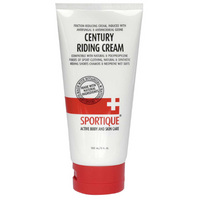Are we ready to “Get Shorty?”
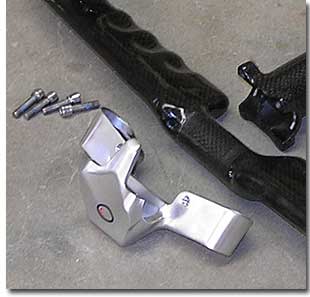
Here it is, the best current sub-assembly for the most anticipated product in triathlon. It's Oval Concepts' A711 Stem Cap Clip-on System. The stem's faceplate keeps its day job (attaching a handlebar to a stem) while moonlighting as the clamp affixing the clip-on extensions. Why is this a big deal? Because extensions are held by clamps, which have to attach to the handlebar. That point of attachment typically has to be round, and this means the handlebar must be round.
Also, the clamps get in the way of the "tops" position (often your contact point while climbing), and they interfere with cable routing. The A711 eliminates all that, and it nicely works with Oval's R910 Aergo bar.
Yes, this is all very nice, but why even mention the R910, Oval's road handlebar? It's designed as a stand-alone road bar, and there is no aero position purpose requisite to its functionality. Are we not taking our eyes off the ball?
See, this is where it gets interesting. Last year I exhorted riders to use the flats that the aero-style road bars give us as a pseudo armrest for the shorty bar. But it was hard to find a nice, well-made, example of that because bars like the R910 go aero immediately upon leaving the stem. I mean, look at in the pic below of that bar. Where are you going to bolt any extension-holding clamp onto it? There's no room. Hence my delight when I came across this Oval faceplate.
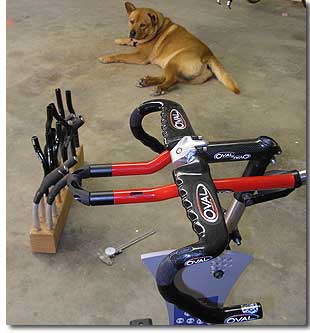
Yes, we need these flats as armrests. Yes, you may choose to wrap some handlebar tape around them. Or you might simply affix some sticky-back neoprene on the tops. Pad your tops to suit. The shape is what's important. If you've got nice, flat tops you've got a good base from which to work.
There are several things a shorty bar must do. If a shorty bar does its job well, then the markets for it are numerous: It's the ITU racer's bar; it's the aero position for those who prefer a road bike to a tri bike; it's the timed-race bar for bike racers who want to take one bike to an omnium; and it's the aero bar for non-racer century riders.
The A711 paired with the R910 tackles most tasks well. The tops are preserved as a usable contact point for seated climbing. The cables are internally routed, and there is no clamp to get in their way, so there's no issue there. The forearm rest is not elevated above the pursuit bar, and there's no armrest trough confining or immobilizing the forearm as it strikes its ergonomic angle while crossing the tops. There is no rearward protrusion of the clamp system interfering with kneecaps while climbing out of the saddle.
Aerobars are going modular. The industry consensus diameter of the extensions is 22.2mm (not that the industry knew it was forming a consensus, it just turned out that way). The four players not conforming are Syntace, Easton and Visiontech, because their extensions aren't portable, and Zipp, which chooses an extension diameter of 22.0mm.
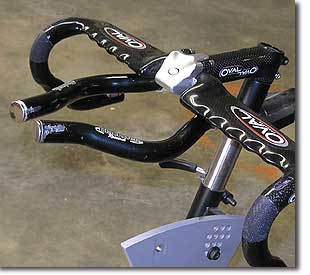
This means the Oval bars can be configured with almost anybody's extension. You might choose a set of Blackwell Wrist Reliefs (adjacent) or go with a set of Oval's S-bends or standard bends.
You can stick just about any bends you want on this bar, as long as you chop off the backs right after they pass through the under-bar clamps. And the clamps are nicely designed for this. Just keep in mind that these are shorty bars, and the extensions are going to have to be cut, and quite severely. Depending on whether you use them for road, or tri, or TT racing, or ITU racing, there are rules regarding the forward protrusion of the aerobars, and the ITU rules are the most stringent of them all.
Even if you are not rulebound, you'll still need to cut these extensions much shorter than would be the case on full tri bars, because a road bike, set up as such, with road geometry, is several centimeters longer than a tri bike. If you don't cut your extensions well short, your shoulder angle will be too obtuse (you'll be too stretched out), and you'll be quite uncomfortable.
This means you're going to have to cut the extensions. If they're aluminum, cut them with a hacksaw or, better yet, a tubing cutter. If they're made of carbon you'll have to be a bit more careful and cut them as you would a carbon fork steerer.
There is an element of concern with this system, and that may require a workaround. Remember that aerobars adjust every which way. You set the pursuit bar pitch to your liking; then pitch the aerobar extensions; and you're good to ride. Not quite so with these. The pitch of the extensions is tied to the pitch of the stem. The faceplate is going to pitch the extensions higher or lower depending on how the stem is pitched. Yes, you can rotate the road bars as you change the stem's pitch, but you can't rotate the extension pitch.
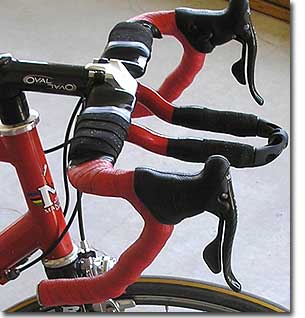
This asks for an ingenious solution. Failing that, it begs tinkering. Me, I'm a better tinkerer than a thinker. In the pic just above, I'm using Wrist Reliefs with a Profile Design bridge. Adjacent, I've got standard-bend Ovals flipped upside down with the bridge. You might flip them rightside up. Or use straight extensions, or S-bends. You will have to tinker, because the stem in the pic at right is a minus-17 degree stem that'll place your stem extension parallel to the ground.
But what if you're going to need a stem with an upward pitch? Yes, you can rotate the road bars so the flat part of the tops are again parallel to the ground, but the stem's now pointing upward. The faceplace is going to be pitched up, which causes your extensions to point upward. You just must find an extension pathway that suits your handhold contact point.
I don't consider this a problem. But it does require tinkering to find that proper extension. The day is coming when bike shops will have a much bigger collection than this. You'll put your bike on the trainer, equipped with a stem that yields the proper fit coordinates, perhaps accepting a faceplate such as this one profiled here. You'll have to try a variety of extensions in order to find that ergonomic hand position you prefer. What's wrong with a process like that?
The price for the set-up above is quite reasonable. An Oval Concepts aluminum stem is $79, the carbon is $149. Inexplicably, Oval's adjustable stem is priced at only $79, if you can't get the precise stem pitch you want. The faceplace is $99. The R910 road bar is $299. Of course you could simply buy the stem and faceplate, and forego the road bar in favor of another, cheaper, road bar.
Oval Concepts makes another faceplate that has a bracket for armrests as well as extenions — it's all part of the same forging. I have the same problem with this that I do with the Profile Design Lightning Strike. In the case of both these full aerobar systems, the armrest pitch or tilt does follow the pitch of the stem. You can't do anything about it. This is a deal breaker. In my opinion, Profile Design needs to to the same thing with its Lightning Strike that Oval Concepts did with its system: hack off the armrest mounts and just let the road bar flats be the armrests.
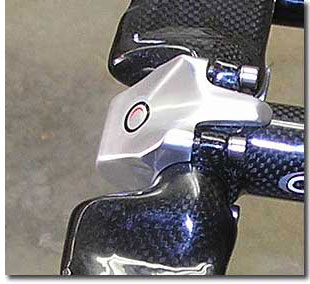
While I'm high on the system above, my enthusiasm is tempered by the need for two products that will be great companions to the stem/faceplate system Oval built, but these two products have not been built yet.
First, one must understand that the ergonomics of shorty bar riding are not the same as they are for full aero bar riding. While triathletes tend to ride their aerobars with palms facing each other, thumbs skyward, road racers ride palms down when they adopt the pseudo aero position. This causes the hands to fall, to droop. If they're going to grab a shorty bar extension, they're going to grab it down where their hands already are — several centimeters in elevation below the tops.
You'll note that I have a bridge joining these bars. I'd rather have a wing out there to grab, extending about 10cm across. I know nothing like this actually exists, as in, for sale. But it should, and this is one of the products that hasn't yet been made.
The other product that needs designing is the road bar onto which the shorty bar will mount. I like my hoods turned slightly up, as a brace when I'm braking, or out of the saddle, or riding with my hands on the hoods. This Oval road bar featured here has pre-drilled holes for cable routing, and I can only turn the hoods up so far on the bars or the hood structure covers the holes. So I must tilt the whole bar. When I do so, the "flat" section tilts up a bit. When I affixed a neoprene pad to the tops, to make an armrest, I had to wedge or cant the neoprene to make the armrest level (then I covered it all with a wrap of handlebar tape, for some stiction).
The bar that needs making is the road bar that (like the Oval bar here) takes its cables internally. The tops, however, need to be molded or formed with a sort of armrest trough built into them. Nothing too awfully fancy, perhaps a depression in which the forearms will rest. But these depressions need to be angled so that the elbows can be splayed a bit wider than usual with full aero bars, the hands will be relatively close together. Again, this is in keeping with the ergonomics of this sort of bar, for this sort of riding.



